Yoginder Sikand reports on his recent journey to Laos — one of the world’s few remaining officially socialist countries. This former French colony, separated from consumerist Thailand by the river Mekong, is an unspoiled oasis of forested misty peaks, placid lakes, and acres of emerald rice fields interrupted by golden spires of Buddhist monasteries
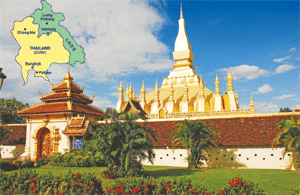 A week in Bangkok and I was fed up. The madding rush of traffic-clogged streets, rampant consumerist frenzy in malls chock-a-block with products that malls the world over stock, hordes of tourists crowding every historic site, imploring pleas from painted dolls offering ‘massage’ and more — had worn me out completely. Even the magnificent Buddhist temples, each a work of art, were insufficient attraction. After visiting almost a dozen — which my guide insisted that no visitor to Bangkok dare miss — each one seemed to resemble the other.
A week in Bangkok and I was fed up. The madding rush of traffic-clogged streets, rampant consumerist frenzy in malls chock-a-block with products that malls the world over stock, hordes of tourists crowding every historic site, imploring pleas from painted dolls offering ‘massage’ and more — had worn me out completely. Even the magnificent Buddhist temples, each a work of art, were insufficient attraction. After visiting almost a dozen — which my guide insisted that no visitor to Bangkok dare miss — each one seemed to resemble the other.
Little wonder a tourist billboard in an inconspicuous eatery grabbed my attention. It advertised forested peaks hidden behind clouds of mist, placid lakes skirted with quaint bamboo huts, verdant islets dotting an enormous river, acres of emerald rice fields stretching into the distant horizon interrupted by golden spires of Buddhist monasteries, and smiling people. Welcome to the People’s Democratic Republic of Laos, the poster announced.
I was susceptible to temptation and yielded to it. Perfunctory research revealed that Laos is one of the world’s few remaining officially socialist countries, and therefore untouched by the ravages of mass tourism. With a population of less than 7 million, this former French colony is sandwiched between China in the north, Thailand to the west, Vietnam to the east and Cambodia in the south. It is one of the most verdant countries in the world, with forest covering 80 percent of its total land area.
At Bangkok’s swank Hualampong railway station, I boarded a train to the border town of Nongkhai to the north, a comfortable overnight journey. From there it’s an hour by bus across the border to Vientiane, the capital city of the Democratic Republic of Laos, a distance of just 20 km. The bus fare: the equivalent of a mere Rs.50.
The border between Thailand and Laos at this point is the mighty River Mekong that flows from the highlands of south China into Laos, and merges with the sea in the Gulf of Siam. Crossing the mile-long Friendship Bridge that spans the Mekong, we entered Laos, and as we sped along the highway towards Vientiane, the sharp material contrast with Thailand came as a shock. Rundown metal and bamboo shacks and wooden houses on rickety stilts lined the road. Drab, depressing Soviet-style office blocks displayed faded signboards. Garbage lay in giant neglected heaps on street corners.
Thirty minutes later we drove into Vientiane’s main bus station, set in the middle of a chaotic, but lively traditional market. Getting off, I changed some money and hailed a tuk-tuk — a roomier version of the Indian auto-rickshaw — to take me to the part of town that my guide-book recommended as suitable for foreign tourists. This part of town shores the Mekong river and boasts rows of old, but well-maintained French-style bungalows, dating back to colonial times, which have been transformed into tourist lodges.
I approved a large double room overlooking a giant Buddhist pagoda in a delightful Chinese-owned inn, cluttered with interesting knick-knacks: Chinese porcelain urns, fruit-bearing bonsai plants, red paper lanterns, bowls of goldfish and tiger prawns, gracefully carved ebony antique furniture, fierce Chinese deities and fading portraits of venerable ancestors glaring down from the walls. All this was provided for the modest price of 75,000 kip per day, approximately Rs.250. Everything in Laos, I was to discover, is much cheaper than in neighbouring Thailand or, indeed, in India for that matter. And although Laos is much poorer compared to its neighbours, its people are warm and charming, making the country one of the most fascinating that I’ve visited in my travels.
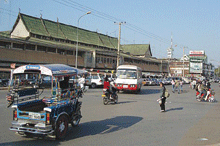 Vientiane (pop. 500,000) is a modest-size city by any but Laotian standards. Mercifully, it has been spared the terrors of capitalist ‘development’, although the city’s landscape is gradually changing. The town has almost no high-rise buildings or shopping malls, to the huge relief of a visitor just out of Thailand, where such structures are ubiquitous even in the rural hinterland. There is little vehicular traffic, since few people can afford cars. Life moves leisurely on Vientiane’s sleepy streets, with most people either walking or using bicycles and tuk-tuks.
Vientiane (pop. 500,000) is a modest-size city by any but Laotian standards. Mercifully, it has been spared the terrors of capitalist ‘development’, although the city’s landscape is gradually changing. The town has almost no high-rise buildings or shopping malls, to the huge relief of a visitor just out of Thailand, where such structures are ubiquitous even in the rural hinterland. There is little vehicular traffic, since few people can afford cars. Life moves leisurely on Vientiane’s sleepy streets, with most people either walking or using bicycles and tuk-tuks.
The major sights of Vientiane, as in the rest of Laos, are wats or Buddhist temples and monasteries. Most of them are set in large, well-tended gardens, lined with stupa-like votive structures for the dead, spirit-shrines that house doll-sized figurines and modest residential quarters for monks and students training to become bhikshuks (wandering ascetics). The main temple structure (wat) is usually a massive hall, topped by multi-layered red-hued slanting roofs.
Each wat is a unique work of art, housing earthly and ethereal statues, some fierce and others benign, of the Buddha in his various avatars and, in some instances, of Hindu mythological figures. A massive gilded image of the Buddha occupies the centre place at the far end of the prayer hall, surrounded by several dozen smaller Buddha statues, some of them embellished with semi-precious stones. Before the main Buddha image there’s usually a wooden altar on which devotees place their offerings: brass water bowls with fresh lotuses, plates containing grains, stubs of incense, and sometimes even bottles of Pepsi! The inner walls are plastered top to bottom with brightly-hued and delicately-crafted paintings depicting images from the Jataka tales about the life of the Buddha. Friendly, ochre-robed monks sit in rows and sonorously chant mantras in Lao and Pali. After prayers, they often practice their English with visiting tourists.
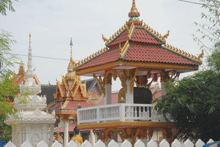 My first two days in Vientiane were spent wat-hopping, and if that was a cultural overload, I found I had hardly covered half of the magnificent shrines dotting the Laotian capital. Curiously the wats in Vientiane except one — the enormous Wat Sisaket — are not more than two centuries old, the earlier ones having been destroyed when the Thais — ironically, fellow Buddhists — invaded the country in the early 19th century. Curiously also, despite decades of communist rule, Laotians enjoy considerable religious freedom. An estimated 70 percent of Laotians are practicing Buddhists. The rest of the country’s population comprises animists of the Hmong tribal ethnic minority, Muslims, Christians and Hindu Indian immigrants.
My first two days in Vientiane were spent wat-hopping, and if that was a cultural overload, I found I had hardly covered half of the magnificent shrines dotting the Laotian capital. Curiously the wats in Vientiane except one — the enormous Wat Sisaket — are not more than two centuries old, the earlier ones having been destroyed when the Thais — ironically, fellow Buddhists — invaded the country in the early 19th century. Curiously also, despite decades of communist rule, Laotians enjoy considerable religious freedom. An estimated 70 percent of Laotians are practicing Buddhists. The rest of the country’s population comprises animists of the Hmong tribal ethnic minority, Muslims, Christians and Hindu Indian immigrants.
By way of historical monuments, Vientiane has little more to offer than its imposing wats. The city has a charm of its own nonetheless, having been spared the baneful impact of mass, mainly Western, tourism a la Thailand. However this hitherto isolated and landlocked country is beginning to experience the impact of globalisation. Taking a cue from across the Thai border, Laos is slowly opening its doors to tourists through the year. Vientiane now boasts a sprinkling of massage parlours, bars, night-clubs, discotheques and handicraft boutiques catering to tourists. Commercial sex, although hardly as rampant as in Thailand, is now a growing business and frenzied, ear-splitting Western music pours out of tourist lodges, where dance-and-drug parties carry on till the wee hours.
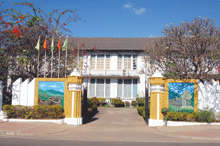 Fortunately the seamy side of Vientiane can be easily avoided, as there are enough other interesting options — at least during a week’s stay. The Laos National History Museum looks drab and forlorn, but it offers interesting insights into Laotian history and culture. Exhibits date back to pre-historic times through the brief period of Hindu ascendancy under the Mon dynasty. Dozens of phallic-shaped votive figurines dedicated to Shiva, and statues of Ganesha testify to the period dating back to around third century AD, when Hinduism entered Laos from Thailand, prior to the import of Buddhism in and around the seventh century.
Fortunately the seamy side of Vientiane can be easily avoided, as there are enough other interesting options — at least during a week’s stay. The Laos National History Museum looks drab and forlorn, but it offers interesting insights into Laotian history and culture. Exhibits date back to pre-historic times through the brief period of Hindu ascendancy under the Mon dynasty. Dozens of phallic-shaped votive figurines dedicated to Shiva, and statues of Ganesha testify to the period dating back to around third century AD, when Hinduism entered Laos from Thailand, prior to the import of Buddhism in and around the seventh century.
French colonial style bungalows and some cafés apart, there’s little historical evidence of French rule (1893-1954) in Indo-China which included contemporary Cambodia, Laos and Vietnam. Following the historic defeat of the French army of occupation at Dien Bien Phu by the legendary Vietnamese General Vo Nguyen Giap, French Indo-China broke up into the independent nations of Vietnam, Laos and Cambodia. But during the period 1965-72 when the US carpet-bombed neighbouring Vietnam, Laos also suffered considerable collateral damage. Therefore unsurprisingly, the bulk of the exhibits in the National Museum have to do with the Lao peoples’ struggle against brutal French and American imperialism and the various contributions — some real, others imaginary — of the Lao Communist Party which still rules this one-party state.
Be that as it may, Vientiane’s main market is a theatre in which one can happily get lost. Spread over several acres, it consists of thousands of stalls divided into separate sections, built on bamboo frames and covered with giant plastic sheets. Almost all the stalls are run by women. The handicrafts section is a collector’s treasure trove, with heavily carved silver knives, swords, plates and ornaments, antique metal ware and porcelain imported from China on display. Also ubiquitous are slim, wooden opium pipes, broad-brimmed straw hats, huge bamboo food containers, bolts of hand-embroidered weaves in a plethora of colours, plus the inevitable plastic toys and trinkets mass-produced in neighbouring China.
Food and farm produce heaped in bamboo baskets occupy pride of place in Vientiane’s main market. Local women, sporting straw hats, traditional long-sleeved shirts and batik sarongs, offer an amazing smorgasbord of meats including an assorted cast of live eels, tiny frogs, baby turtles, giant wasps, and even larvae, termites and ants. These local delicacies are sold by weight. I even spotted a dead civet cat — a rare species headed towards extinction — being chopped into little bits on a stone slab by a brutal looking matron perched on a stool. Surrounding her were transparent jars of fermented quail and swallow eggs, fried flying squirrels and rats neatly wrapped in plastic packets. This gastronomic menu sent me reeling and, adding to that, a college student nudged me and chuckled, “Across the street is a Vietnamese restaurant that you might want to visit. It specialises in dog-meat steak.”
At sunset, large crowds gather on the banks of the Mekong at one end of Vientiane. At this point the river moves sluggishly, laden with rich alluvium that it drags down from the mountains of southern China and northern Laos. Country boats and wooden dug-outs float past lazily, ferrying passengers from upstream. Thailand is clearly visible on the other side of the river, hardly a mile away. Vientiane is perhaps the only national capital worldwide, located bang on an international border.
The riverfront is a vivid tableau of everyday life. Makeshift hairdressers set up shop on stools shaded by large parasols; masseurs and women offer facials. Children peddle colourful but pathetic-looking birds trapped in bamboo cages, soliciting visitors to acquire religious merit by paying to release the hapless avians. Mobile food stalls — cane baskets slung across poles and carried by women — do brisk business, selling cubes of dried meat stuck on bamboo slivers or like lollipops wrapped in leaves; dried frogs, an amazing variety of fresh fish straight from the river, and loops of noodles that come in various shapes and colours.
As a committed vegetarian, all I could settle for then — and I survived on for the rest of my stay in Laos — was a bowlful of hot, sumptuous clear noodle soup with greens. Thus I sipped my soup sitting on the banks of the Mekong on a mat lent by a vendor of ‘make-you-strong medicine’ — a potent brew of fermented rice filled into bottles containing dead snakes or scorpions to add to its fire — a Laotian aphrodisiac.
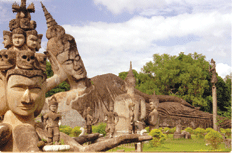 Twenty-five kilometers from Vientiane is the village of Xieng Khuan, known for its kitschy, but not-to-be-missed, Buddha Park. The road to Xieng Khuan runs parallel to the Mekong, with Thailand visible all along, on the other side of the meandering river. The park is set in an idyllic environment — a bamboo forest replete with sacred Bodhi trees, under which the Buddha attained enlightenment. Amid more than a 100 statues of the Enlightened One scattered all over the park, a 60 metre reclining Buddha occupies pride of place, surrounded by engraved images of smaller Buddhas in various other poses. Secularly, idols of Hindu deities with slit-eyes and dressed in Laotian garb also abound in the Buddha Park — goddess Durga astride a tiger; a four-headed and five-armed fierce Shiva image; Vishnu seated on a snake throne, and even an image of Guru Nanak, crowned by a conical Laotian peasant’s hat!
Twenty-five kilometers from Vientiane is the village of Xieng Khuan, known for its kitschy, but not-to-be-missed, Buddha Park. The road to Xieng Khuan runs parallel to the Mekong, with Thailand visible all along, on the other side of the meandering river. The park is set in an idyllic environment — a bamboo forest replete with sacred Bodhi trees, under which the Buddha attained enlightenment. Amid more than a 100 statues of the Enlightened One scattered all over the park, a 60 metre reclining Buddha occupies pride of place, surrounded by engraved images of smaller Buddhas in various other poses. Secularly, idols of Hindu deities with slit-eyes and dressed in Laotian garb also abound in the Buddha Park — goddess Durga astride a tiger; a four-headed and five-armed fierce Shiva image; Vishnu seated on a snake throne, and even an image of Guru Nanak, crowned by a conical Laotian peasant’s hat!
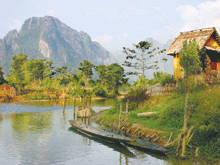 A five hour bus-ride from Vientiane, rising into the Laotian highlands that stretch northwards to the China border, is the settlement of Vang Vieng. En route, the bus passes through stunningly scenic countryside, and thickly forested mountains, their tops blanketed by clouds of mist. Waterfalls cascade down wet emerald slopes and join rivulets hurrying through densely carpeted valleys. Numerous varieties of orchids and ferns sprout from fruit-bearing trees that line the narrow road. Peasant boys and sleepy-eyed buffaloes spend lazy days in huge lakes glimmering in the sun. Thus days and nights drift by in rural Laos.
A five hour bus-ride from Vientiane, rising into the Laotian highlands that stretch northwards to the China border, is the settlement of Vang Vieng. En route, the bus passes through stunningly scenic countryside, and thickly forested mountains, their tops blanketed by clouds of mist. Waterfalls cascade down wet emerald slopes and join rivulets hurrying through densely carpeted valleys. Numerous varieties of orchids and ferns sprout from fruit-bearing trees that line the narrow road. Peasant boys and sleepy-eyed buffaloes spend lazy days in huge lakes glimmering in the sun. Thus days and nights drift by in rural Laos.
The bus skirts lush paddy fields and scattered hamlets dotted with neat bamboo cottages, dwarfed by Buddhist temples. Then, as it ascends higher, we enter wild forest inhabited by Hmong tribals, the poor relations of ethnic Laos. Their bamboo houses with neat thatched roofs are built on stilts, with the space below used for storing produce and sheltering animals, plus serving as a play area for children. Large black denuded splotches sear green forest along the way — the result of a centuries-old Hmong tradition of slash-and-burn agriculture, which the government has not been successful in banning.
With drugs and psychotropic substances easily available, Vang Vieng is a favourite haunt of Caucasian junkies, and the havoc drug tourism has caused to local culture and traditions is painfully evident. Nevertheless the environs of Vang Vieng are famous for limestone caves located deep in the forest. Access to the caves necessitates a testing trek up steep hills beyond the Mekong, where the only sounds heard are of crickets and frogs. This is the pristine habitat of dragonflies in dozens of electric colours, massive water spiders and avian sized butterflies. Deep within the caves, gnarled stalactites, formed over thousands of years point downward from the roof, guarding hundreds of serene Buddha statues.
In this offbeat outpost, the mysterious caves prompted me to make Vang Vieng my base for three days. I would have liked to spend more time exploring them, but glaze-eyed western tourists, staying up nights partying, dancing and drugging, induced me to change my plans. I packed my rucksack and hopped aboard a country bus heading north towards the China border, which, my guide-book assured me, is still largely unspoiled by mass tourism. More later...